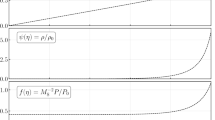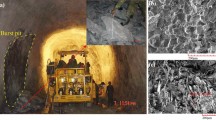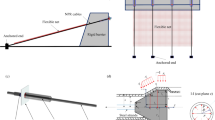Abstract
An experimental investigation of elastic waves produced by the axial collision of strikers with truncated 2024 aluminum cones with apex angles of 0.48, 5.38, 20, and 30 deg was performed. Wave propagation was initiated at the small end of all four cones and at the large end of the 0.48-deg and 5.38-deg cones. The striker consisted of a 1/2-in.-diam steel ball or a soft phenol-impregnated fiber cylinder. In most cases, impact was caused by firing the striker from an air gun at approximately 1300 ips; in an additional series of tests, a steel ball was dropped on the cone. The metamorphosis of the pulse at the surface of the target was recorded using both foil and semiconductor resistance strain gages. Data were obtained for periods ranging from 200 to 500 μsec; this permitted the observation of several reflections from the ends of the specimen. In several instances, cylindrical aluminum rods were glued to the cone to form a composite target; this permitted observation of the initial pulse incident on the conical section both from surface strain gage and sandwiched crystal records. Studies were also conduced to ascertain the stress distribution across the base of the 20-deg cone.
Initial pulse records were employed to predict the surface response in the target using the one-dimensional equation of elastic wave propagation in a cone of infinite length. Reasonable agreement between the data and the results of calculations based on the analysis was obtained.
Similar content being viewed by others
Abbreviations
- A :
-
area of cross section
- c :
-
phase velocity
- c 0 :
-
rod wave velocity
- c s :
-
shear wave velocity
- E :
-
Young's modulus
- f,F :
-
function
- g :
-
acceleration of gravity
- r :
-
distance from cone apex
- R :
-
radius of cross section
- t :
-
time
- u :
-
displacement
- v 0 :
-
initial velocity of striker
- v f :
-
final velocity of striker
- α:
-
total cone angle
- ε:
-
strain
- Δ:
-
wavelength
- μ:
-
Poisson's ratio
- ρ:
-
density
- σ:
-
stress
References
Landon, J. W., andQuinney, H., “Experiments with the Hopkinson Pressure Bar,”Proc. Royal Soc. of London, Series A,103,622 (1923).
Donnell, L. H., “Longitudinal Wave Transmission and Impact,”Trans. Am. Soc. Mech. Engrs.,52,153 (1930).
Favre, H., “Etude théorique de l'influence d'une discontinuité de la section droite d'une barre conique sur la propagation des vibrations elastiques longitudinales,”Bull. Tech. de la Suisse Romande,88 (24),353 (1962).
Reed, R. P., “Stress Pulse-Trains from Multiple Reflection at a Zone of Many Discontinuities. A Notation for Machine Solution”, Sandia Corporation Research Report, 4462 (August 1962).
Alcoa Aluminum Handbook, Aluminum Company of America, Pittsburgh, Pa. (1959).
Alcoa Structural Handbook, Aluminum Company of America, Pittsburgh, Pa. (1930).
Dove, R. C., andAdams, P. H., “Experimental Stress Analysis and Motion Measurement,”Chas. E. Merrill Books, Inc., Columbus, Ohio (1964).
Cunningham, D. M., andGoldsmith, W., “Short-time Impulses Produced by Longitudinal Impact,”Proc. Soc. for Exp. Stress Anal.,16,153 (1959).
Davies, R. M., “A Critical Study of the Hopkinson Pressure Bar,”Royal Soc. London Philosophical Trans., Series A,240,375 (1948).
Goldsmith, W., andLyman, P. T., “The Penetration of Hard-steel Spheres into Plane Metal Surfaces,”Jnl. Appl. Mech.,27,717 (1960).
Goldsmith, W., Polivka, M., andYang, T. L., “Dynamic Behavior of Concrete,”Experimental Mechanics,6 (2),65–79 (1966).
Kolsky, H., “Stress Waves in Solids,” Dover Publications (1963).
Kenner, V. H., “Wave Propagation in Conical Bars,”M.S. Thesis, University of California, Berkeley (1967).
Bishop, R. E. D., “Longitudinal Waves in Beams,”Aero Quart.,3,part 4,280 (1952).
Gurtin, M. E., “The Effects of Accelerometer Low-frequency Response on Transient Measurements,”Proc. Soc. for Exp. Stress Anal.,18,206 (1961).
Okada, A., Cunningham, D. M., andGoldsmith, W., “Stress Waves in Pyramids by Photoelasticity,”Experimental Mechanics,8 (7),289–299 (1968).
Author information
Authors and Affiliations
Rights and permissions
About this article
Cite this article
Kenner, V.H., Goldsmith, W. Elastic waves in truncated cones. Experimental Mechanics 8, 442–449 (1968). https://doi.org/10.1007/BF02327408
Issue Date:
DOI: https://doi.org/10.1007/BF02327408




